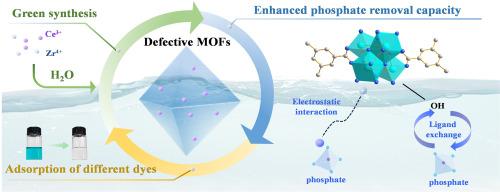掺杂铈(III)的缺陷mof增强磷酸盐去除和染料吸附
IF 6.7
2区 工程技术
Q1 ENGINEERING, CHEMICAL
引用次数: 0
摘要
磷酸盐和染料是废水中常见的两种污染物,但同时去除它们的研究还很有限。本研究通过金属掺杂策略合成了缺陷cexzr1 -1,3,5-苯三羧酸(BTC),其中x表示Ce与Zr的摩尔比。以水和乙酸(HAc)为溶剂和调节剂,分别合成了缺陷mof,取代了传统合成方法中的N, N-二甲基甲酰胺(DMF)和甲酸(FA)。用热重法和电位酸碱滴定法定量缺失连接的数量。通过粉末x射线衍射(PXRD)和x射线光电子能谱(XPS)证实了CeXZr1-BTC的成功合成。在投加量为0.2 g/L、初始磷酸盐浓度为200 ppm、pH为2、温度为303 K的条件下,Ce0.75Zr1-BTC表现出良好的吸附性能(234.7 mg/g)。此外,得益于更多的吸附位点和更少的内部扩散限制,在连续使用四次后,它仍保持了95%以上的磷酸盐去除效率,能够处理392层体积的磷酸盐溶液。Ce0.75Zr1-BTC在混合染料溶液中可选择性吸附阴离子染料,吸附机理主要包括静电吸引、π-π堆积和氢键作用。将模拟含磷染料废水的磷酸盐浓度降至1.17 μg/L,显著降低COD,显示了其在实际废水处理中的应用潜力。本文章由计算机程序翻译,如有差异,请以英文原文为准。

Defective MOFs doped with cerium (III) for enhanced phosphate removal and dye adsorption
Phosphates and dyes are two common pollutants in wastewater, yet research on their simultaneous removal remains limited. In this study, defective CeXZr1-1,3,5-Benzenetricarboxylic acid (BTC) were synthesized via a metal doping strategy, where x denotes the molar ratio of Ce to Zr. Defective MOFs were synthesized using water and acetic acid (HAc) as the solvent and modulator, respectively, replacing N, N-dimethylformamide (DMF) and formic acid (FA) in the traditional synthesis method. The number of missing linkers was quantified using thermogravimetry analysis and potentiometric acid-base titration. The successful synthesis of CeXZr1-BTC was confirmed by powder X-ray diffraction (PXRD), and X-ray photoelectron spectroscopy (XPS). Ce0.75Zr1-BTC showed a great phosphate adsorption performance (234.7 mg/g) under optimized conditions, with a dosage of 0.2 g/L, an initial phosphate concentration of 200 ppm, pH 2, and a temperature of 303 K. Additionally, benefiting from more adsorption sites and reduced internal diffusion limitations, it retained more than 95 % phosphate removal efficiency after four consecutive applications and was able to treat 392 bed volumes of phosphate solution. Furthermore, Ce0.75Zr1-BTC could selectively adsorb anionic dyes in mixed dyes solution, and the adsorption mechanisms mainly involve electrostatic attraction, π-π stacking, and hydrogen bonding. It reduced phosphate concentrations to 1.17 μg/L and significantly lowered the COD of simulated phosphate-containing dye wastewater, demonstrating its potential for practical wastewater treatment applications.
求助全文
通过发布文献求助,成功后即可免费获取论文全文。
去求助
来源期刊

Journal of water process engineering
Biochemistry, Genetics and Molecular Biology-Biotechnology
CiteScore
10.70
自引率
8.60%
发文量
846
审稿时长
24 days
期刊介绍:
The Journal of Water Process Engineering aims to publish refereed, high-quality research papers with significant novelty and impact in all areas of the engineering of water and wastewater processing . Papers on advanced and novel treatment processes and technologies are particularly welcome. The Journal considers papers in areas such as nanotechnology and biotechnology applications in water, novel oxidation and separation processes, membrane processes (except those for desalination) , catalytic processes for the removal of water contaminants, sustainable processes, water reuse and recycling, water use and wastewater minimization, integrated/hybrid technology, process modeling of water treatment and novel treatment processes. Submissions on the subject of adsorbents, including standard measurements of adsorption kinetics and equilibrium will only be considered if there is a genuine case for novelty and contribution, for example highly novel, sustainable adsorbents and their use: papers on activated carbon-type materials derived from natural matter, or surfactant-modified clays and related minerals, would not fulfil this criterion. The Journal particularly welcomes contributions involving environmentally, economically and socially sustainable technology for water treatment, including those which are energy-efficient, with minimal or no chemical consumption, and capable of water recycling and reuse that minimizes the direct disposal of wastewater to the aquatic environment. Papers that describe novel ideas for solving issues related to water quality and availability are also welcome, as are those that show the transfer of techniques from other disciplines. The Journal will consider papers dealing with processes for various water matrices including drinking water (except desalination), domestic, urban and industrial wastewaters, in addition to their residues. It is expected that the journal will be of particular relevance to chemical and process engineers working in the field. The Journal welcomes Full Text papers, Short Communications, State-of-the-Art Reviews and Letters to Editors and Case Studies
 求助内容:
求助内容: 应助结果提醒方式:
应助结果提醒方式:


